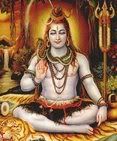
This little piece is dedicated to the charming Anoushka Thakur, who left JJ and I with moist eyes after her much-too-brief visit to Bangalore. We bless her that the music in her takes tangible form and illuminates the world some day.
The high-point in our rapidly dying culture has been the exalted status of classical music. Due to the forbidding aura of unfathomable secrets that surround it, many abandon its exploration even before they start, a grave loss for future generations. May I suggest boldly approaching this mental barrier and making a small effort to cross it to get a glimpse of the wonders available to us for the asking.
The Raaga Bhairav has highly esoteric connotations. It may be considered the primordial musical scale in many ways. It is precisely the same as the Carnatic Raaga Mayamalavagowla.A simple description of the musical elements of Bhairav is here.
All seven notes exist in the ascendent and the descendent. Technical analysis fails in the face of practical considerations. Never mind. Associate if you will, for a moment, Bhairav with Shiva. Bhairavi then associates with Parvati. Bhairav is deep and calm, and subdues the restless mind. Bhairavi adds to restlessness due to its stimulation of many musical patterns born within us. But I digress.
Here is Bhairav by Rashid Khan. Notice the particular quality of the percussion heightening the mystical quality of Bhairav.
Bhairav contains the note Komal Rishab. Easing into it or leaving it requires the exercise of gray matter and deep respect. The note must stand alone and linger and not sway to the extent possible. Thats just one view (mine) and others may differ. And they may be right.
A certain little-known book in fact claims
This note, this Komal Rishab, is the sound of peace across the Universe.
Later, we find
All Raags come from me. I permit them to exist and I finally destroy them. From me springs Bhairavi, intoxicating, permitting every emotion to express itself through her. She is my mate, my Ardhangani, my half, but only because I allow her be so. I am the ultimate expression, seeking neither approval nor even acknowledgement of my existence.
Imagine that!
Bhairav is a Thaat (root) too. That means there can be hundreds of variants that owe their existence to Bhairav.
Here are some:
- Shivmat Bhairav
- Bhavmat Bhairav
- Saurashtra Bhairav
- Bhairav Bahar
- Jogiya
- Gauri
- Kalingada
- Ahir Bhairav
- Kaushi Bhairav
- Ramkali (Popular in Sikh Shabads)
- Gunakali
- Anand Bhairav
- Mangal Bhairav
- Lalit: This Raaga will give you early morning shivers
- Lalit Pancham
- Vibhas: This Raag may be gainfully compared with the interesting and more popular Bhupali or Bhoop of the Kalyan Thaat.
- Beehad Bhairav
Closely aligned is Charukesi, borrowed from Carnatic music, with a deeper touch of pathos, achieved by the use of Komal Nishad and the stress on Shuddha Gandhar.
Ahir Bhairav and Nat Bhairav are twins, in my raw mind. As a violinist, I see it vividly on strings, but its difficult to convey. The swapping of Shuddha and Komal Dhaivat and Rishab notes are best illustrated by demonstration. For that, I invite you home for tea.
The sheer dignity and classical depth of this Raaga and its derivatives should be enough to calm the soul of the most troubled by speaking of eternity and illusion. I highly recommend it.
All hail English Literature lovers and critics! Send constructive suggestions my way!
I must point out that all sources are freely available in the public domain. I have done nothing special here. You could do the same if you are so inclined.
Do note that I am no expert; I freely accept that I am a novice. For a much better analysis, I refer you to Rajan Parrikar's page here.

2 comments:
Hi
Really interested in your blog. I'm writing a Masters dissertation on the komal rishab across different world cultures and want to know more about your ideas around this note. Peace across the universe. Nice. What draws this conclusion for you? How would you use that understanding while playing Bhairav raag?
Hoping you get this communication as I send it,
Sarah, England
Hello Sarah
Please get in touch with me via email and we can discuss this
vmurthy88 @ gmail dot com
Regards
Vasudev
Post a Comment